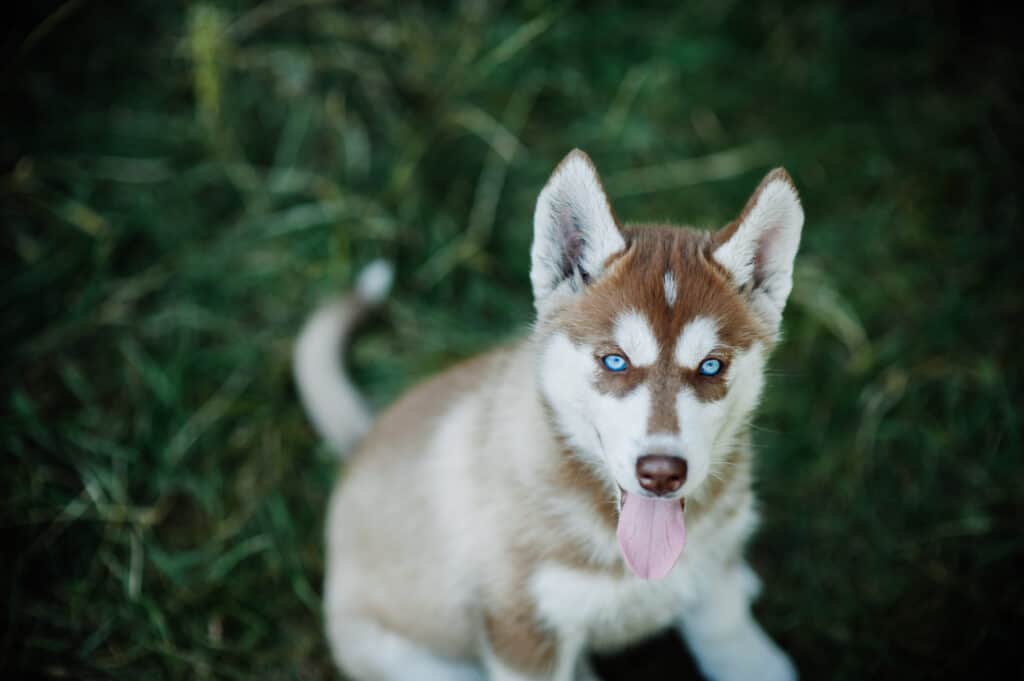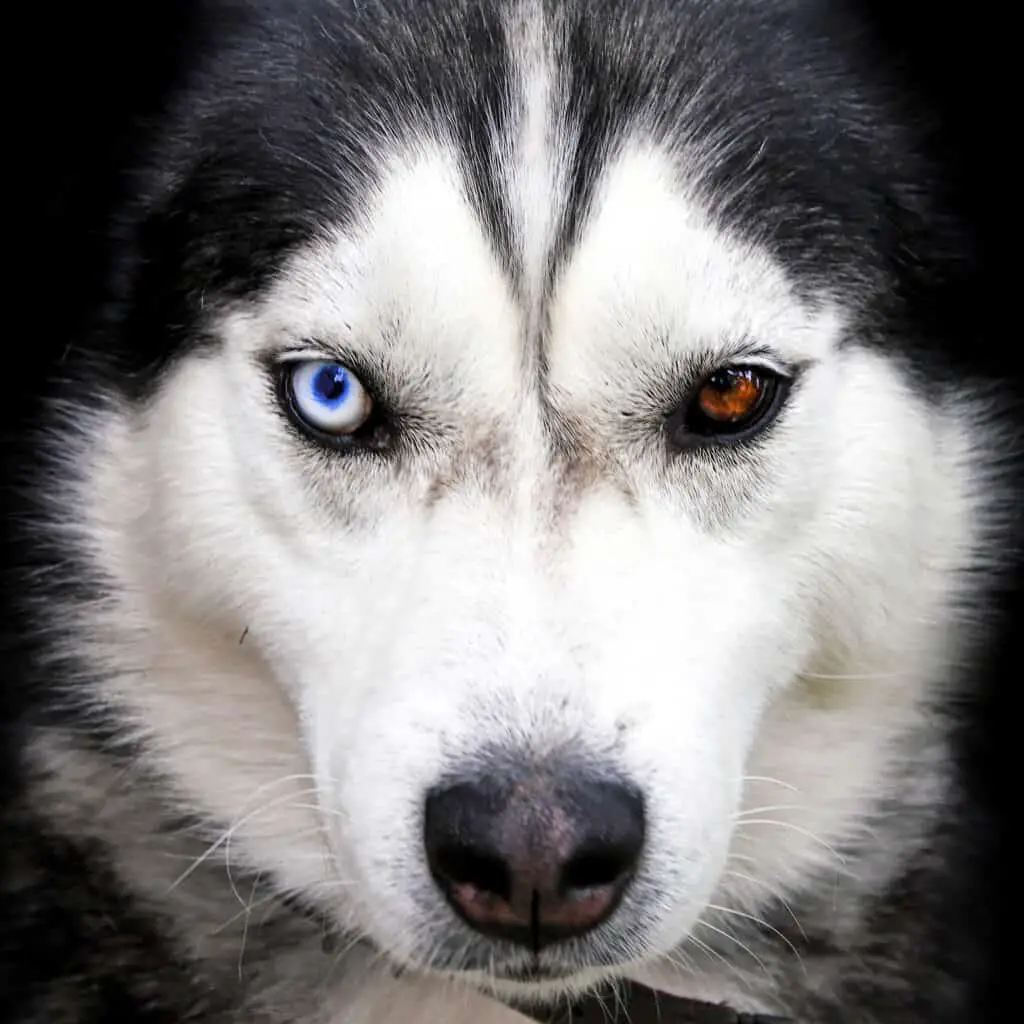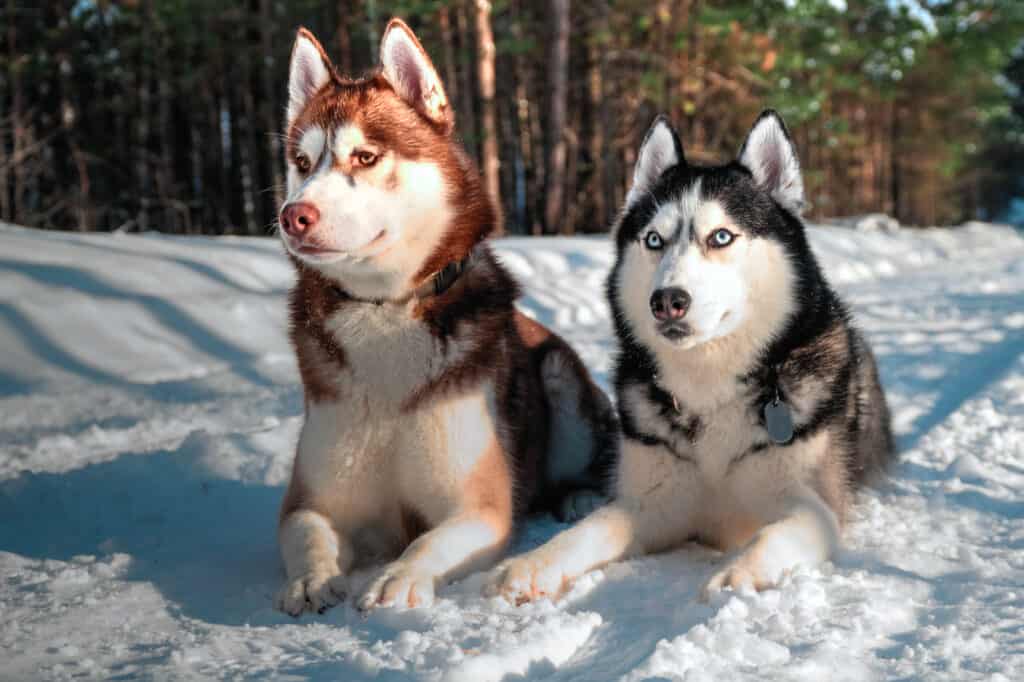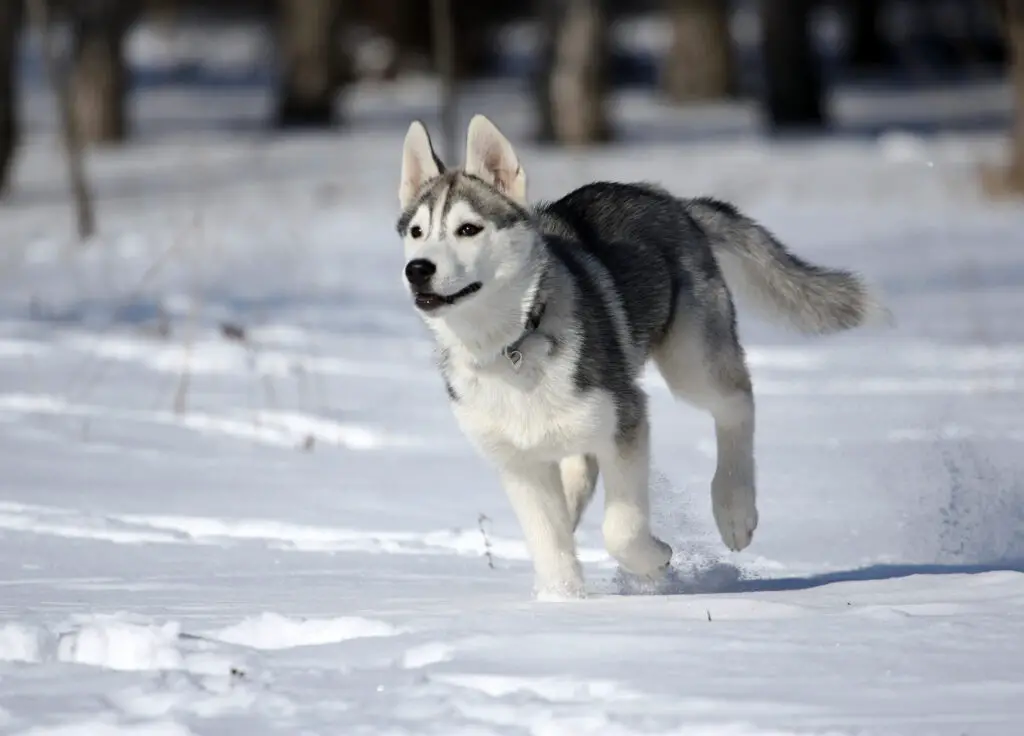Our website is supported by our users. We sometimes earn money when you click an affiliate link and make a purchase. This is at no extra cost to you and helps us to create quality content. Thank you for your support. For all that have shown us such wonderful support, we thank you from the bottom of our hearts!
The Siberian Husky is a distinctively attractive and resilient breed of dog that has gained popularity for its incredible endurance, striking appearance, and sled-pulling abilities. Originating from Siberia, this medium-sized working dog was cherished by the Chukchi people as a sled dog and loyal companion.
Known for their thick, double coat, triangular erect ears, and captivating markings, the Siberian Husky has a notable presence which contributes to their growing appeal.

You’ll find that despite their high-energy nature and intense work ethic, these dogs can be incredibly affectionate, gentle, and make exceptional pets with proper care. Their grace, elegance, and mischievous disposition make the Siberian Husky a breed worth considering for an addition to your family.
Understanding the Siberian Husky’s origins, characteristics, and care requirements will help you better appreciate this fascinating and versatile breed. From their sturdy build designed to pull light loads at moderate speeds to their playful, social demeanor, Siberian Huskies are a unique and captivating breed.
History of The Siberian Husky
The Siberian Husky, a breed known for its endurance and speed, has a rich history that originates from the harsh climates of Siberia. As mentioned, the Chukchi people, indigenous to eastern Siberia, bred these dogs for their transportation needs.
Due to their impressive sled-pulling abilities, the Siberian Husky was pivotal in the Chukchi’s survival in the unforgiving weather conditions.
In the early 1900s, the Siberian Husky made its way to Alaska in the United States to participate in sled dog races. The breed’s ability to withstand cold temperatures while carrying heavy loads made them a popular choice for these events.
One such race, Nome’s All-Alaska Sweepstakes, saw extraordinary feats from these dogs. The team led by John “Iron Man” Johnson won the 1910 race with a record-breaking time of 74 hours, 14 minutes, and 37 seconds.
Over time, the Siberian Husky gained more recognition and moved beyond the racecourses of Alaska. In 1930, the breed earned its official status with the American Kennel Club (AKC) and solidified its place in canine history. Furthermore, the Siberian Husky Club of America was established in 1938, promoting the breed even further.
One particularly famous Siberian Husky is Balto, the lead sled dog in the 1925 serum run to Nome, Alaska. This historic event showcased the Siberian Husky’s incredible stamina, as the sled team raced nearly 700 miles through treacherous conditions to deliver vital medicine to the city of Nome. Today, you can find a historical marker in Nome as a tribute to these incredible dogs.
Remember, the Siberian Husky is not a wolf nor a hybrid of one. Its ancient lineage dates back at least 4,000 years, making it a distinct and remarkable breed in its own right.

Physical Characteristics of The Siberian Husky
When you first look at a Siberian Husky, you’ll notice its medium size, typically weighing in between 35 to 60 pounds. Their height stands at about 20 to 24 inches tall at the shoulder, showcasing a well-balanced and compact physique.
One of the most striking features of this breed is its coat. The Siberian Husky boasts a double coat consisting of a dense, soft undercoat and a longer, thick outer coat. This thick coat provides essential protection from harsh, cold climates, making them the ultimate sled dogs.
Their coat comes in a wide range of colors and markings, adding to their stunning appearance. Common colors include black, white, grey, and red, often combined with white. Some huskies may also display unique mask-like facial markings that set them apart from other breeds.
Additionally, the eye colors of Siberian Huskies can vary, making them truly mesmerizing. While many have bright blue eyes, it’s not uncommon to see huskies with brown, amber, or even bi-colored eyes – with each eye being a different color, also known as heterochromia.

In summary:
- Size: 20 to 24 inches tall, 35 to 60 pounds
- Coat: Double coat with a thick outer coat and a soft undercoat
- Colors: Black, white, grey, red (often combined with white)
- Markings: Unique facial markings, masks are common
- Eye colors: Blue, brown, amber, bi-colored (heterochromia)
- Huskies generally have a good life span of 12 to 15 years.
Caring for your Siberian Husky’s beautiful coat is important. Regular brushing will help remove loose hairs and keep it healthy. However, be prepared for seasonal shedding when their thick undercoat will molt, leaving you with some extra grooming duties.
Overall, as you admire and care for your Siberian Husky, you can’t help but appreciate the unique combination of strength, agility, and beauty this breed possesses.
Temperament & Training of Siberian Husky
Siberian Huskies are known for their friendly, playful and gentle temperament. Their intelligence and independence are notable traits, and they often display a mischievous personality. As a would-be Siberian Husky owner, it is critical to understand their temperament, exercise needs, and training requirements to ensure a happy, healthy bond with your dog.
Training your Siberian Husky will require patience, consistency, and a positive attitude. Due to their high energy levels and stubborn nature, it’s essential to invest time in socialization and obedience training…a lot of training.
Socialization should begin at a young age, ideally during the first few months of your Husky’s life. Expose them to various environments, people, and other animals to foster their friendly and outgoing personality. It’s crucial to reinforce good behavior with treats, positive reinforcement, praise, and playtime, as this will encourage your Husky to continue exhibiting positive traits.
When it comes to exercise, Siberian Huskies have high energy needs. To maintain their physical and mental well-being, pet parents should aim to provide at least 1 to 2 hours of daily physical activity. This can include walks, runs, or engaging in games such as fetch and tug-of-war.
Remember to keep the exercise sessions varied and engaging to keep your dog’s interest.
- Key Training Tips:
- Start socialization and training early
- Be patient, consistent, and positive
- Frequent exercise and mental stimulation
- Offer rewards for good behavior
- Vary training and exercise sessions to keep them engaging
Always consider your Husky’s individual temperament and personality while training, as no two dogs are the same. Like any breed, Siberian Huskies may have unique quirks (they are very vocal dogs), preferences, and habits. By understanding these traits, you’ll foster a strong bond and create a happy, well-adjusted companion.
Health Issues of The Siberian Husky
As a Siberian Husky owner, it is essential to be aware of certain health conditions that can affect your beloved pet. By understanding these conditions, you can be proactive in maintaining your Husky’s health and ensuring they lead a happy and active life.
Hip Dysplasia
One common health problem that Huskies face is hip dysplasia. This painful form of arthritis is widespread in medium to large working breeds and affects many Huskies, regardless of their age. Hip dysplasia occurs when the leg bone doesn’t properly fit into the hip bone.
Cataracts
Another health issue that may concern your Husky is cataracts. Their striking blue eyes can be prone to developing problems at an early age. Cataracts may impair their vision, so it is crucial to have regular check-ups with your veterinarian to monitor the health of their eyes.
Progressive Retinal Atrophy
Additionally, though less common, Huskies may suffer from Progressive Retinal Atrophy (PRA). This condition involves the degeneration of the retina over time, leading to blindness at night and eventually affecting their vision during the day. PRA affects less than 1% of Huskies, with males being predominantly at risk.
Corneal Dystrophy
Corneal dystrophy is another eye-related health issue that Huskies face. This condition affects the transparent front part of the eye, causing loss of transparency and visual disturbances. Regular check-ups with a veterinarian can help in early detection and managing the issue.
In summary, being aware of these health issues can help you better care for your Siberian Husky and allow them to lead a full and happy life. Regular veterinarian check-ups, a balanced diet, and proper exercise are essential components in ensuring the health and well-being of your beloved pet.
Grooming Your Siberian Husky
Siberian Huskies are a breed known for their thick double coat and distinctive markings. Proper grooming is essential for their health and well-being. In this section, we will discuss several aspects of grooming your Siberian Husky, including brushing, bathing, cutting fur/hair, clipping or grinding nails, dental care, and cleaning ears.
Brushing
Regular brushing is crucial for maintaining your Husky’s coat and reducing shedding. Their double coat consists of an undercoat and guard hairs. The soft undercoat acts as insulation, while the guard hairs protect against the elements.
During shedding seasons, it’s important to brush your Husky more frequently to remove the excess undercoat.
You should start with a slicker brush if you have kept up with their brushing. However, if your dogs is matted you will want tools to help break them up. This combination pack of both a de-matting comb and tool will help you get down deep into the knots.
Bathing
Bathing your Siberian Husky should be done sparingly, as frequent baths can strip the coat of its natural oils, leading to dry skin and irritation.
When bathing, wet the coat thoroughly and apply a dog-friendly shampoo in circular motions against the wet coat. This tool, the ELEGX Pet Grooming Bath Massage Brush, helps to get down to the undercoat and skin
Always avoid getting water in your Husky’s eyes or ears. Rinse well and use a hairdryer on a low heat setting to dry them thoroughly. Most Huskies will let you know that they do not like this process…very loudly.
Cutting Fur/Hair
Trimming the hair on your Husky’s paws and between their toes is necessary for their comfort and cleanliness.
Use a pair of grooming scissors to carefully trim the hair, ensuring not to cut too close to the skin. This helps to prevent matting and provides better traction on slippery surfaces.
Additionally, you can lightly trim the fur around the tail and ears to maintain a neat appearance.
Clipping or Grinding Nails
Regular nail maintenance is essential for your Husky’s comfort and overall health. Overgrown nails can cause pain or even impair your dog’s movement. Use a dog nail clipper or grinder to trim your dog’s nails, being cautious not to cut the quick (the sensitive part) inside the nail. If you’re unsure about the proper technique, consult a professional groomer or your veterinarian.
Also, you can check out our article on How to Grind Your Dog’s Nails.
Dental Care
Dental care plays a vital role in your Husky’s overall health, as poor dental hygiene can lead to gum disease and other issues.
Incorporate brushing your dog’s teeth into your grooming routine using a specially designed dog toothbrush and toothpaste.
Additionally, provide dental chews or toys to help keep their teeth clean.
Cleaning Ears
Clean your Siberian Husky’s ears regularly to prevent infections and buildup of debris. Using a dog-friendly ear cleaner and a soft cloth or cotton ball, gently clean the outer edges of the ear, avoiding the ear canal.
For an easy fix, you can use the Pet MD – Dog Ear Cleaner Wipes – Otic Cleanser for Dogs.
Monitor your Husky’s ears for signs of irritation or infection, such as redness, swelling, or foul odor, and consult your veterinarian if you notice any issues.
By following these grooming guidelines, you can keep your Siberian Husky clean, comfortable, and healthy. Remember, a well-groomed Husky is not only a happy dog but also a beautiful companion.
Owning a Siberian Husky
When considering owning a Siberian Husky, it’s essential to understand the various aspects of their care, including cost, grooming, and exercise needs.
Costs: The initial cost of purchase for a Siberian Husky can range from $500 to $1500, depending on the breeder and pedigree. Maintenance costs, such as food, grooming, and medical care, can add up over time. It’s essential to budget for these expenses accordingly.
Grooming Costs: Siberian Huskies are known for their thick double coat, which requires regular grooming to keep it healthy and clean. Brushing their coat multiple times a week, and more frequently during shedding season, is necessary. You may want to invest in grooming tools or professional services.
Medical Costs: Routine medical care, such as vaccinations and annual checkups, are essential for keeping your Siberian Husky healthy. Additionally, be prepared for possible health issues, such as hip dysplasia or eye problems, which may require further medical attention and costs.
Adopting a Siberian Husky: Instead of purchasing from a breeder, consider adopting a Siberian Husky from a shelter or rescue organization. Adoption fees can be lower than purchasing from a breeder, and you’ll be giving a deserving dog a loving home.
Finding Breeders: If you decide to purchase from a breeder, do thorough research and connect with the Siberian Husky Club of America to find reputable, responsible breeders to avoid supporting unethical breeding practices.
Diet and Exercise Needs: Siberian Huskies are an active and energetic breed, which means they require a well-balanced diet and daily exercise to maintain their health.
A high-quality dog food should suffice, and it’s crucial to provide them with ample opportunities for physical activity, such as daily walks or runs.
Siberian Huskies are also known for their escape artist tendencies, so ensure your yard is securely fenced to prevent them from wandering off.
Cat-Friendly…not: While each Siberian Husky is an individual, they generally have a high prey drive, which means they may not be the best companion for cats, ferrets, rabbits or birds.
However, early socialization with other pets in the household may improve the chances of a peaceful coexistence.
In conclusion, by understanding the various aspects of Siberian Husky ownership and care, you can provide a loving and suitable home for your new canine companion. Adopt from a shelter if you can but if you choose to find a breeder choose only from the best Siberian Husky Breeders.
Frequently Asked Questions
What are the physical characteristics of a Siberian Husky?
Siberian Huskies are medium-sized dogs, with males standing at 21 to 23.5 inches tall and weighing 45 to 60 pounds, while females measure 20 to 22 inches tall and weigh 35 to 50 pounds. They have thick double coats to withstand cold temperatures, and their eyes can be blue, brown, or a combination of both. The Husky’s coat can come in various colors and patterns, including black, gray, red, and white.
What specific care requirements do Siberian Huskies have due to their habitat?
Siberian Huskies are originally from cold climates, which means they can struggle in warmer environments. To keep them comfortable, provide plenty of shade, fresh water, and avoid exercising them during the hottest parts of the day.
Their thick double coat requires regular brushing to remove loose hair, especially during shedding seasons. Exercise is crucial for Huskies due to their high energy levels; daily physical activity combined with mental stimulation is ideal to keep them happy and healthy.

Are there notable differences in temperament between a black Siberian Husky and other color variations?
There is no scientific evidence to support that color variations, including black Siberian Huskies, have different temperaments compared to other colors within the breed. Their personality traits typically depend on genetics, environmental factors, and individual upbringing. Regardless of their color, Siberian Huskies are generally friendly, affectionate, and intelligent dogs.
Why do Siberian Huskies scream?
Siberian Huskies are known for their unique vocalizations, including howling, whining, and so-called “screaming”.
This behavior can be triggered by excitement, boredom, loneliness, or anxiety. Keeping your Husky mentally and physically stimulated will help reduce the chances of excessive vocalizations. Training from an early age, using positive reinforcement and patience, can help teach your Husky to be quiet on command.
What are some distinctive qualities that make Siberian Huskies unique as a breed?
Siberian Huskies are known for their exceptional endurance, as they were originally bred for pulling sleds across long distances. Their thick double coats help them withstand harsh weather conditions, and their striking eye colors make them stand out among other breeds.
They have a strong prey drive, making them prone to chasing smaller animals, and they are known for being great escape artists. Finally, their friendly and social nature makes them an excellent companion for those who can meet their exercise and grooming needs.
The Bottom Line on the Siberian Husky

When it comes to choosing a Siberian Husky as your companion, there are several factors to consider. First and foremost, you should be prepared for a highly energetic, sociable, and intelligent dog that requires tons of exercise. As a breed primarily raised for sled racing, they crave physical activity and mental stimulation.
The Siberian Husky is known for being a friendly and gentle breed, which makes it an excellent family dog. However, it’s important to establish yourself as a strong pack leader to ensure they respond well to training and learn proper behaviors. Additionally, be mindful of the fact that they may not be the best guard dogs due to their trusting nature.
Keep in mind that the Siberian Husky is a talented escape artist, always on the lookout for an opportunity to break free. So, you’ll need a secure environment to prevent them from wandering off. When it comes to grooming, they do require regular maintenance with their dense, double-coated fur. Be prepared for seasonal shedding, too.
In terms of size, the Siberian Husky is a medium-sized dog, with males typically weighing between 45 and 60 pounds while females weigh between 35 and 50 pounds. This makes them a manageable size for most living situations.
Here’s a quick summary of the Siberian Husky’s features:
- Highly energetic and intelligent
- Sociable and friendly
- Excellent family dog
- Requires exercise and mental stimulation
- Needs a strong pack leader
- Talented escape artist
- Regular grooming required
Remember, a Siberian Husky may not be the perfect fit for everyone, but if you’re ready to commit to their exercise, training, and grooming needs, they can be an incredibly rewarding and loving companion for you and your family.
Please read our Legal Disclaimer






